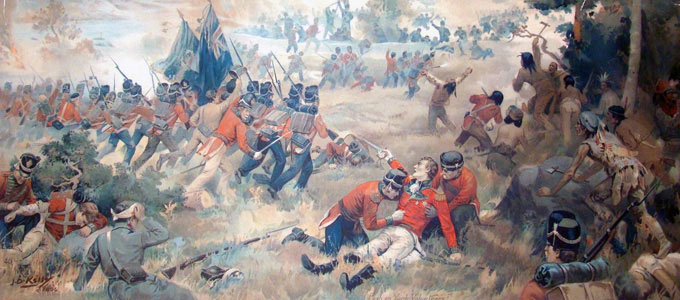
The Battle of Queenston Heights
Early in the morning on October 13th, 1812, members of The United States Regular Army, coupled with militia units under the leadership of Major-General Stephen Van Rensselaer, crossed the Niagara River from Lewiston in the hopes of capturing the village of Queenston and gaining a foothold on Canadian soil before the campaign season was over. If the Americans were successful in capturing Queenston they would cut off supplies to the Western part of Upper Canada as Queenston was part of the portage road used to transport goods around Niagara Falls.
Between 3:00a.m and 5:00a.m the first wave of Americans came over in bateaux, and so the Battle of Queenston Heights began. The Americans found early success capturing the redan battery and gaining control of the Heights above the village. Brock understood too well the danger of losing the village of Queenston if he did not regain the redan battery and the Heights as quickly as possible. He rode into the village and quickly assembled a small band of 49th Regiment soldiers and militia who followed him up the escarpment to regain the Heights.
The Americans expected a counter attack and fanned out among the trees, and began to fire on the British. George Jarvis, a young volunteer, noted that Brock "led the way up the mountain at double quick time in the very teeth of a sharp fire from the enemy's riflemen, and ere long he was singled out by one of them, who, coming forward, took deliberate aim and fired; several of the men noticed the action and fired-but too late-and our gallant General fell on his left side, within a few feet of where I stood. Running up to him I enquired, 'Are you much hurt, Sir?' He placed his hand on his breast and made no reply, and slowly sunk down." Brock's body was quickly removed in the smoke and confusion of Battle, and hidden in the village of Queenston. Brock's Aide-de-Camp, Lieutenant-Colonel John Macdonell, led a counter-attack but was mortally wounded leaving the Americans in control of the Heights.
While the small number of British forces stationed in Queenston Heights waited for reinforcements to arrive, approximately 100 Native Warriors under the leadership of John Norton climbed the Heights and started harassing the American Forces, keeping them contained on the Heights. By the early afternoon British regulars had arrived from Fort George and Chippewa. Under the leadership of Roger Hale Sheaffe, they fought alongside the Native Warriors, Canadian Militia, and Runchey's Corps, repelling the American invaders on the Heights and forcing a surrender which saw approximately 1,000 men taken prisoner. The British suffered very few casualties; however, they had lost their leader, Major- General Sir Isaac Brock who was shot through the chest while trying to regain the redan battery.
The Battle of Queenston Heights was the first major engagement in the War and the British victory, coupled with the previous victories at Forts Mackinac and Detroit, gave Upper Canadians new hope in the British cause and unified the population behind the war effort.
Top image courtesy of the Niagara Historical Society and Museum.
